Hostage Rescue Team
The Hostage Rescue Team (HRT) is the elite tactical unit of the Federal Bureau of Investigation (FBI).[3] The HRT was formed to provide a full-time federal law enforcement tactical capability to respond to major terrorist incidents throughout the United States.[3] Today, the HRT performs a number of tactical law enforcement and national security functions in high-risk environments and conditions and has deployed overseas.[4]
| Hostage Rescue Team | |
|---|---|
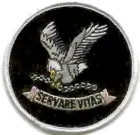 Patch of the Hostage Rescue Team | |
| Active | August 1983 – present[1] |
| Country | |
| Agency | |
| Type | Police tactical unit |
| Role | Law enforcement Counter-terrorism Special operations |
| Operations jurisdiction | National International |
| Part of | Critical Incident Response Group |
| Headquarters | Quantico, Virginia, U.S. |
| Motto | Servare Vitas "To save lives" |
| Abbreviation | HRT |
| Structure | |
| Operators | 149[2] |
| Commanders | |
| Notable commanders | Danny Coulson |
The HRT, along with the Crisis Negotiation Unit (CNU), the SWAT Operations Unit that manages the field office SWAT program, and the Tactical Helicopter Unit (THU), comprise the Tactical Section of the FBI's Critical Incident Response Group (CIRG).[4] The Hostage Rescue Team was founded in 1982 by Danny Coulson, former Deputy Assistant Director of the FBI, and completed its final certification exercise in October 1983. It was originally composed of 50 operators, later increased to over 90.
History
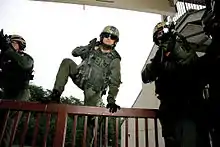
The HRT was originally conceived during the late 1970s and was set up after FBI director William H. Webster witnessed a demonstration by the U.S. Army's Delta Force. When Webster reviewed the equipment used by the Delta Force and noticed there were no handcuffs, he inquired about it. An operator grimly replied, "We put two rounds in their forehead. The dead don't need handcuffs."[5] The HRT was originally to be an augmented SWAT and counter-terrorist team, capable of handling extraordinary hostage situations, large-scale counter-terrorist operations, situations involving nuclear or biological agents, or operations that local law enforcement or the regional FBI field office were not trained or equipped to handle. Final approval for the HRT was given in early 1982, and formal planning began in March that year. The initial HRT selection course was held in June 1982 and consisted of three groups of 30 candidates each. Most candidates were experienced SWAT team members. Of this group, 50 candidates were selected to continue to more advanced training.
Upon completing its initial selection, the newly formed HRT began acquiring the equipment it considered necessary and upgrading training facilities at Quantico. One of its first projects was the construction of a "shoot house", built entirely out of old tires, to allow the team to conduct live-fire training exercises.
The final touches were added to the facilities just before Thanksgiving 1982 and, after a short holiday break, the team began its initial training program. After receiving tactical SWAT instruction, each individual was given expertise to research, such as explosives and door breaching tactics. Each operator also served as a liaison to one of the existing elite counter-terrorism teams from around the world.
As part of their liaison duties, the men attended training exercises held by their assigned counter-terrorism unit and shared their experiences with the team. The team spent most of January 1983 honing their shooting and tactical skills at Quantico, and then traveled to Fort Bragg, North Carolina, in February for a month of training and instruction with the US Army's Delta Force. The team returned to Quantico for further training. It became operational in August 1983.[6]

The team's final certification exercise, code-named Operation Equus Red, was held in October 1983 at Kirtland Air Force Base, New Mexico. During the exercise, the HRT, a local SWAT team, and a United States Department of Energy Nuclear Emergency Search Team (NEST) were tasked with assaulting a terrorist stronghold. The "terrorist" group was also believed to be in possession of a simulated nuclear device, which was at a separate location and had to be recovered or neutralized. After the NEST aircraft confirmed the location of the device, HRT operators infiltrated the terrorist safe house, secured the device, and managed to "kill" the terrorist involved in approximately 30 seconds. The FBI's senior leadership viewed the exercise as a complete success and granted final approval for the team to become fully operational.[6]
Upon completion of the certification exercise, the HRT began to expand its capabilities by sending small teams of operators out for more specialized training courses. Approximately a dozen operators visited Naval Amphibious Base Coronado to receive combat diver, maritime operations, and tactics (such as visit, board, search, and seizure—VBSS) training from the United States Navy SEALs. Other team members conducted helicopter operations and aerial insertion training with the US Army's Task Force 160. Every operator also received 80 hours of medical training. The HRT traveled to Camp Peary, near Williamsburg, Virginia, for counter-terrorism training courses to develop skills in breaching barricades, running roadblocks, and defensive driving.[6]
Over time, HRT operators studied with the U.S. military, along with local, federal, and foreign tactical teams, and attended private courses to learn more about air assault tactics, rappelling, close quarters combat, chemical agents, terrorist psychology, surveillance methods, sniping/counter-sniping, communications and more. Tactics learned during training were shared with the team. Eventually, for close quarter battle training, the HRT decided to make things more realistic on advice from SEAL Team Six (later known as the United States Naval Special Warfare Development Group or DEVGRU) commander Richard Marcinko, and the HRT introduced blood bags and wax bullets. The wax bullets were used for team-versus-team drills.[5]
The HRT became part of the Critical Incident Response Group upon its formation in 1994, due to the need to consolidate the assets necessary to respond to a critical incident in one group. Since being added to Critical Incident response group, HRT has been used to conduct law enforcement operations and counterterrorism operations globally, often deploying with military special operations forces and intelligence units.
Capabilities
The HRT's equipment and tactics are the most advanced of the FBI's 56 SWAT teams and the 14 enhanced SWAT teams. The HRT's capabilities are distinguished because the HRT operators (assault and sniper teams) serve full-time and train daily. While never advertised as such, HRT operators are fully trained commandos on par with Department of Defense special operations units.
The HRT has the ability "to deploy within four hours, with part or all of its personnel and resources, to any location within the United States or its territories".[6] The unit is able to operate in a variety of environments (chemical, extreme cold, night and low-light, or rural environments).[7] The HRT's tactical teams have the ability to fast-rope, a technique in which the team rapidly descends a rope from the side of a helicopter. This technique is useful for deploying troops into an area where a helicopter cannot touch down. Even more advanced capabilities are possessed by the HRT, including High Altitude Low Opening (HALO) parachute operations, to name just one. The HRT's capabilities include advanced ground tactics, advanced maritime operations, and advanced tactical aviation operations.
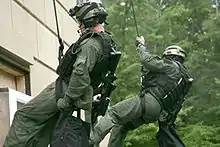
Maritime capabilities
The HRT, as a whole, possesses enhanced capabilities in the maritime domain, including advanced "breaching" capabilities (the ability to circumvent locked doors aboard a ship) and ship-boarding capabilities. The HRT has vessels that are outfitted for maritime assaults, most of which have been upgraded since 2004.[8]
HRT also has a specialized maritime team with additional maritime capabilities including subsurface diving, closed-circuit diving (scuba gear that does not emit bubbles), and combat swimming. All operators on the maritime team are military trained in closed-circuit diving and combat swimming. In addition, an operator of the maritime assault team element is qualified to pilot and operate a freighter.
Aviation capabilities
The HRT's Tactical Aviation Unit is staffed by FBI special agents. The Tactical Helicopter Unit, a sub-unit of the Tactical Aviation Unit, contains a variety of specially modified helicopters. These include military converted tactical Sikorsky UH-60 Black Hawks and tactically enhanced Bell 412s and Bell 407s. Unlike the military, whose aircraft are not always in the same location as their tactical operators, the HRT's Tactical Helicopter Unit is in the vicinity of HRT central command. The HRT's tactical aviators are required to fly daily.[9]
Roles
The primary roles of the HRT are hostage rescue and counter-terrorism. Secondary roles of the HRT include:
- Apprehending barricaded subjects;
- Executing helicopter operations and rescue missions;
- Executing mobile assaults;
- Performing high-risk raids, searches, arrests, and warrants;
- Coordinating manhunt and rural operations
- Providing force protection for FBI personnel overseas.
To a lesser extent, the HRT may deploy teams or individual operators to act as snipers, or to provide protective service details for certain high-profile federal witnesses or dignitaries. Teams provide support for missions overseas and support Joint Terrorism Task Forces. Teams at home and abroad perform typical law enforcement activities, such as making arrests, processing scenes for evidence recovery, and testifying in court.[10]
The HRT has provided traditional law enforcement during hurricane relief operations, tactical surveys, and special events such as the Olympic Games, presidential inaugurations, and political conventions.[11]
Selection and training
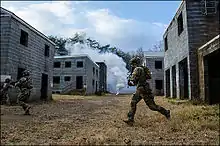
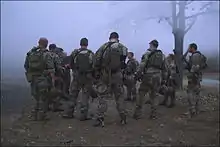
Prospective HRT operators are selected based upon their background and experience, as well as their demonstrated performance during the HRT selection course. The rigorous two-week selection process includes long-distance runs, forced marches, obstacle courses, and other tests of physical and mental stamina. Throughout the entire selection process, candidates are evaluated on their ability to think under pressure and to perform whilst physically exhausted. After a six-month initial training period known as "New Operator Training School" ("NOTS"), they are headquartered at the FBI Academy in Quantico, Virginia. Both the selection course and NOTS are near mirror images of the 1st SFOD-D ("Delta Force") selection and training courses, with some minor adjustments for mission differences.
Experienced HRT operators assigned to observer/sniper teams are sent to the United States Marine Corps Scout Sniper Basic Course. After successfully completing the course, they receive further instruction from HRT snipers. Maritime HRT operators are sent to a variety of maritime special operations courses, including Phase II of U.S. Navy BUD/S at Naval Amphibious Base, Coronado, California.
When not operationally deployed, the HRT conducts full-time training for its members at various locations throughout the country. Two to three hours each day are set aside for physical training, a defensive tactics session, and combative training. One day a week is devoted to maintaining either perishable skills (such as fast roping, breaching, and photography) or specialized skills (such as mobile assaults, manhunt and rural operations), maritime operations, helicopter operations, parachuting, weapons of mass destruction training (provided by the United States Department of Energy), and cold weather operations. Three days are spent honing sniping or close quarters combat skills on the various training ranges available to the team. Biweekly, one day is allotted for gear maintenance. Discretionary time to be used by team leaders is built into the schedule. During a routine week of training, it is not unusual for HRT operators to fire thousands of rounds to keep their shooting skills honed. Every 12 to 18 months, the HRT also participates in at least one major combined exercise that may involve a variety of governmental entities, such as the FBI and the Departments of Defense, State, Energy, and Homeland Security.
Three teams rotate through three 120-day cycles: training, operations, and support.[10] During the training cycle, the team refreshes its skills and takes part in exercises, attends other courses, or trains with foreign and domestic units. During the operations cycle, the team is available for deployment (domestic or foreign). During the support cycle, the team works on special projects, maintains the HRT's equipment, and conducts research.[8]
The HRT is known to conduct joint training exercises and participate in exchange programs with some U.S. military units such as the Army's Combat Applications Group (otherwise known as 1st SFOD-D or Delta Force) or the Navy's DEVGRU (SEAL Team Six). The HRT routinely trains with other federal tactical teams such as the DEA's FAST Team, the United States Border Patrol's BORTAC unit or the United States Capitol Police's CERT. Occasionally the HRT trains with French GIGN, British Special Air Service and Special Boat Service, Irish ERU, the Australian SAS, German GSG 9, Italian GIS (Gruppo di Intervento Speciale), and other international units as well as assist in the formation of corresponding units within the NATO framework such as the Hellenic Coast Guard Special Missions Echelons (ΚΕΑ ΛΣ/ΕΛ.ΑΚΤ.).[6][12] In addition to the HRT's own facilities, the HRT routinely uses private and 1st SFOD-D Delta Force shoot houses and ranges. The HRT has also been known to train at Camp Peary and Harvey Point.[13]
Operations
Since its inception, the HRT has been involved in many of the FBI's most high-profile cases, executing numerous operations involving domestic militant groups, terrorists, and violent criminals. The first test of the team's capabilities came in the summer of 1984 when the team deployed to Los Angeles as part of the security buildup prior to the 1984 Summer Olympic Games.
Some cases have brought the HRT a lot of attention. The HRT came under increased public and Congressional scrutiny, along with federal law enforcement in general, due to what some saw as heavy-handed tactics used at Waco and Ruby Ridge.
On the other hand, the HRT has been involved in over 200 successful missions, both in the US and abroad.[14] Many of these operations have received little or no attention from the world press. HRT has been deployed to and conducted combat operations in both Iraq and Afghanistan, for example.[15]
Some higher-profile cases include the Waco siege; Ruby Ridge; the capture of the suspected masterminds of the 1998 bombings of the US embassies in Africa; the rescue following the 2013 abduction of a five-year-old boy in Alabama;[16] the hostage rescue operations of prison guards at Talladega, Alabama, and St. Martinville, Louisiana; and the January 29, 2016 confrontation with militants involved in the occupation of the Malheur National Wildlife Refuge. On April 19, 2013, the Hostage Rescue Team arrested a man in Watertown, Massachusetts, after a manhunt for Dzhokhar Tsarnaev, one of two perpetrators of the Boston Marathon bombing of April 15.[17] HRT rescued a teenager by killing her abductor on August 10, 2013.[18] HRT rescued kidnap victim Frank Arthur Janssen.[19] The HRT assisted in the capture of Eric Frein, the sole suspect in the 2014 Pennsylvania State Police barracks attack.[20] The FBI HRT was deployed to the 2016 Republican National Convention and the 2016 Democratic National Convention.[21]
Casualties
The HRT has suffered four known fatalities, all training related. The first was James K. McAllister,[22] who died during a fast rope training exercise in 1986. The second known fatality was Gregory J. Rahoi, who died in a live fire exercise in 2006.[23]
In May 2005, an FBI HRT McDonnell Douglas 530 helicopter crashed while conducting a fast rope exercise. Crew members sustained injuries, but none were life-threatening.
On May 17, 2013, HRT suffered two fatalities, Christopher Lorek and Stephen Shaw, involving a helicopter while training off the coast of Virginia Beach.[24][25]
Equipment
The Hostage Rescue Team uses a wide variety of equipment.[26][27]
Firearms
Pistols
Sub-machine guns
- Various Heckler & Koch MP5 variants (9×19mm Parabellum and 10mm Auto)
Assault rifles
Battle rifles
Shotguns
- Benelli M4 (12-gauge)
- Remington Model 870 (12-gauge)
Machine guns
- M60 machine gun (7.62×51mm NATO)
- M249 light machine gun (5.56×45mm NATO)
Sniper rifles
- Heckler & Koch MSG90 (7.62×51mm NATO)
- Custom Remington Model 700 (7.62×51mm NATO)
- Barrett M82 (.50 BMG)
Grenade launchers
Grenades
Vehicles
- Chenowth "dune buggy" (Desert Patrol Vehicle, Light Strike Vehicle or Advanced Light Strike Vehicle)
- Chevrolet Suburban
- Humvee
- General Motors Diesel Division Canada Bison
- Ford Pickups: Ford F-150, F-250, F-350, Super Duty
- Chevrolet Blazer
- Certain Specialized Vehicles
Aircraft
The HRT's helicopters are operated by their Tactical Helicopter Unit. The HRT can also make use of aircraft belonging to the Critical Incident Response Group's Aviation Special Operations Unit.
Notable operators
- Danny Coulson: FBI HRT founder and former commander. Later, Coulson became the deputy assistant director of the FBI. Prior to creating the HRT, Coulson served on one of the FBI SWAT teams, more specifically a sniper team, and he later commanded one of the most active SWAT teams in the FBI. In 1984, Coulson led a team of FBI agents to apprehend the neo-Nazi terrorist Robert Jay Matthews on Whidbey Island; while Matthews died in the ensuing shootout, no FBI personnel were harmed. In November of 1987, Coulson was the FBI's tactical commander tasked with handling the Atlanta prison riots. Later appointed the Special Agent in Charge of the FBI's Dallas office, Coulson served as one of the Bureau's commanders of the investigation of the Oklahoma City bombing. Coulson retired from the FBI in 1997. As of July 2009, Danny Coulson is a successful security consultant, author, and guest speaker.
- Lon Horiuchi: Former FBI HRT operator and sniper who shot Vicky Weaver in the head while she was holding her infant daughter during the Ruby Ridge standoff. Horiuchi was also deployed during the Waco Siege. He was later charged with manslaughter for the death of Vicky Weaver, but the charges were dismissed. It has been reported that prior to the Oklahoma City bombing, terrorist Timothy McVeigh had plotted to assassinate Horiuchi.
- Christopher Whitcomb: Former FBI HRT operator and sniper. Whitcomb spent 15 years with the FBI and was involved with the Waco Siege, Los Angeles riots of 1992, and Ruby Ridge. As of February 2012, Whitcomb is an American author and appeared as an "expert" on the NBC game show Identity.
- James K. McAllister: The first of the HRT's four known casualties. Special Agent McAllister died on April 18, 1986 after falling out of a helicopter during an HRT training exercise at the FBI Academy in Quantico, Virginia. McAllister had been one of the original 50 members of the Hostage Rescue Team. McAllister had first joined the FBI as a support employee in 1970 before becoming a special agent in 1976. He first worked as a special agent in Baltimore and New York before being assigned to the Washington office where he joined the HRT. His wife, Kimberly, was also an FBI agent and the couple had two children together.
- Sean M. Joyce: 14th Deputy Director of the FBI. Joyce served for over 26 years in the FBI. Besides his service in the HRT, Joyce was also a Joint Terrorism Task Force Supervisor, Section Chief of the Counterterrorism Division's International Terrorism Operations Section, Assistant Director of the International Operations Division and a SWAT Team Commander. Joyce was appointed Deputy Director of the FBI in 2011 and held that office until 2013; in this capacity, he had daily oversight of the FBI's 36,000 personnel and its multi-billion dollar budget.
- Gregory J. Rahoi: The second HRT casualty, Gregory Rahoi died on December 6, 2006. Rahoi was accidentally shot and fatally wounded at Fort A.P. Hill in Caroline County, Virginia, during a live fire tactical training exercise designed to prepare him for his deployment to Iraq. Rahoi had been assigned to the HRT for six years, during which he served three tours in Iraq. He worked as a firefighter, paramedic, police officer, and lawyer in Wisconsin prior to joining the FBI. He earned an undergraduate degree in criminology and sociology from Marquette University in 1989 and earned a law degree from Marquette University Law School in 1993. He served for one year as a police officer in the town of Shorewood, Wisconsin before transferring to the Madison Police Department prior to joining the FBI in 1997. He was selected for the HRT in 2000. He was posthumously awarded the FBI Medal of Valor for acts of heroism during his final Iraq tour, and his family was presented with the FBI Memorial Star.[28]
- Thomas R. Norris: Original member of the HRT as an assault team leader. Former US Navy SEAL and a Medal of Honor recipient. Saved Lieutenant Colonel Iceal Hambleton in the infamous Bat-21 mission. He later lost an eye during a mission in Vietnam and was known for being the first HRT member with one eye. Norris applied to join the FBI in 1979 but had to request a medical waiver due to the loss of his eye. Then-director of the FBI William Webster personally waived the medical requirement after Norris passed the Bureau's preliminary examinations. Norris served as an FBI agent for 20 years.
- Stephen P. Shaw: The third or fourth (see below) of the Hostage Rescue Team's casualties. On May 17, 2013, Shaw took part in a helicopter-based, maritime counterterrorism exercise off the coast of Virginia Beach, Virginia. Shaw was preparing to fast-rope from his helicopter onto the deck of a ship as part of the exercise, but the helicopter experienced technical difficulties and spun out of control. Shaw fell from the helicopter into the sea; it is believed that he was killed upon impact. Shaw's HRT teammate, Christopher Lorek, was also killed in the accident. Shaw had joined the FBI as a special agent in 2005 and had previously worked in U.S. Immigration and Customs Enforcement.
- Christopher Lorek: The third or fourth (see above) of the Hostage Rescue Team's casualties. On May 17, 2013, Lorek took part in a helicopter-based, maritime counterterrorism exercise off the coast of Virginia Beach, Virginia. Lorek was preparing to fast-rope from his helicopter onto the deck of a ship as part of the exercise, but the helicopter experienced technical difficulties and spun out of control. Lorek fell from the helicopter into the sea; it is believed that he was killed upon impact. Lorek's HRT teammate, Stephen Shaw, was also killed in the accident. Lorek graduated from Texas A&M University in 1993 and first joined the FBI as a support employee in 1996 before becoming a special agent in 1998.
- Gordon M. Snow: A graduate of the University of Michigan and United States Marine Corps veteran, Snow joined the FBI in 1992. Snow was assigned to the Hostage Rescue Team in 1996, taking part in numerous sensitive operations and was attached to the State Department; during this time, he took part in investigations of the bombing of the USS Cole and the bombings of the U.S. Embassy in Nairobi, Kenya. In 2001, Snow was appointed the Director of Counterintelligence for the Middle East. In 2005, Snow was appointed Chief of the FBI's Weapons of Mass Destruction and Acquisition of U.S. Nuclear & Missile Technology Unit at FBI Headquarters. In 2007, Snow deployed to Afghanistan as the on-scene commander of the FBI's Counterterrorism Division. He was later appointed the Assistant Director of the FBI's Cyber Division in 2009 and held that position until retiring from the Bureau in 2012. He now serves as the Director of physical security for the Cleveland Clinic in Cleveland, Ohio.
- James A. Gagliano: A 25-year FBI veteran. Gagliano graduated from West Point in 1987 and served as an infantry officer in the U.S. Army before becoming an FBI special agent in 1991. He was selected for the Hostage Rescue Team in 1997, taking part in numerous operations before returning to the New York Office in 2001, where he was appointed SWAT Team Leader, commanding one of the Bureau’s most active SWAT teams. From 2002 to 2003, he deployed three times to Afghanistan as the FBI attachment to the U.S. military's Joint Special Operations Command. He was later appointed the Crisis Management Coordinator of the FBI's New York Office, having oversight of the SWAT team, Special Agent Bomb Technicians and other hazardous first response elements. He also served as the Deputy Legal Attache and Acting Legal Attache in Mexico City, Mexico and served as the Special Assistant to the Assistant Director in Charge, Chief of Staff for the FBI's New York Office. Retiring from the FBI in late 2015, Gagliano joined CNN as a law enforcement analyst and served as an adjunct professor at St. John's University in New York City, teaching courses on national security. He is also a doctoral candidate at St. John's.
In popular culture
- The protagonist of the 2018 film Skyscraper, who is portrayed by Dwayne Johnson, is a former HRT operator.
- HRT operators appear in Silence of the Lambs as they attempt to arrest serial killer "Buffalo Bill" and rescue his hostage.
- The 1991 film Toy Soldiers depicts a fictional rescue operation carried out by the FBI HRT.
- FBI HRT operators appear in popular first person shooter games such as Counter Strike: Global Offensive and Rainbow Six Siege and The Sum of All Fears
- In the American political TV drama House of Cards, the Season 4 finale included FBI HRT operators raiding a potential terrorist hideout.
- HRT units are regularly portrayed in the American TV drama, The Blacklist.
- The film Patriots Day shows FBI HRT operators breaching a dormitory at UMass Dartmouth, where Dzhokar Tsarnaev was believed to be residing.
- The Disney video game G-Force has FBI HRT operators show up after the first chapter at the Saber Mansion. Despite their uniforms being marked "FBI" and "HRT", they more closely resemble generic SWAT officers.
- Hostage Rescue Teams are involved in both Patriot Games and The Cardinal of the Kremlin.
- The video games Payday: The Heist and Payday 2 involve federal Hostage Rescue Teams to free civilians that were taken hostage by heisters.
- In the horror role-playing game Delta Green, HRT operator is a profession for player characters that work for the FBI.
- In the 2015 action horror film, Navy Seals vs. Zombies, it is mentioned that HRT operators were deployed to rescue the Vice President before being killed by zombies.
Notes and references
- "Timeline - FBI". FBI.
- Federal Tactical Teams: Characteristics, Training, Deployments, and Inventory (PDF) (Report). United States Government Accountability Office. September 10, 2020. GAO-20-710. Retrieved 25 January 2021.
- "The Hostage Rescue Team: 30 Years of Service". Federal Bureau of Investigation. February 1, 2013.
- "CIRG - FBI". Federal Bureau of Investigation. Retrieved 25 January 2021.
- U. S. Counter-Terrorist Forces.
- "TacLink - FBI HRT". Specwarnet.net. Retrieved 2012-01-14.
- “Anything, Anytime, Anywhere” The Unofficial History of the Federal Bureau of Investigation’s Hostage Rescue Team (HRT) Archived December 4, 2008, at the Wayback Machine
- "The Federal Bureau of Investigation's Efforts to Protect the Nation's Seaports". Usdoj.gov. Retrieved 2012-01-14.
- "The FBI is Home to Some of the Baddest Special Ops Aviators Around". The Tactical Air Network. 23 November 2015. Retrieved 16 July 2018.
- "Training the FBI's tactical elite". Archived from the original on 2012-12-08.
- Federal Bureau of Investigation - Investigative Programs - Critical Incident Response Group Archived July 10, 2007, at the Wayback Machine
- "Rank and Structure in the Garda Sı´ocha´na and the Role of the Emergency Response Unit". 2006. Barr Tribunal. Retrieved 3 May 2014.
- "Author Profile: Christopher Whitcomb". Bookreporter.com. Retrieved 2012-01-14.
- "FBI Agents Were Deployed in Hundreds of JSOC Raids Conducted in Iraq & Afghanistan". Shadowproof. 2014-04-11. Retrieved 2016-06-12.
- "Inside the FBI's secret relationship with the military's special operations". Washington Post. Retrieved 2016-06-12.
- Brown, Robbie; Campbell Robertson (2013-02-04). "Standoff in Alabama Ends in Boy's Rescue and Kidnapper's Death". The New York Times. Retrieved 2013-02-07.
- "Boston Marathon shooting Saturday". CBC News. Archived from the original on September 27, 2013. Retrieved 2016-06-12.
- "FBI — Statement of Special Agent in Charge Mary Rook on the Rescue of Hannah Anderson". FBI. Retrieved 11 May 2015.
- "Elite FBI unit rescues N.C. kidnap victim, Frank Arthur Janssen, in Atlanta". 10 April 2014. Retrieved 11 May 2015.
- "Police seize Eric Frein's food supplies". PennLive.com. Retrieved 11 May 2015.
- http://www.news5cleveland.com/news/local-news/oh-cuyahoga/elite-fbi-units-in-town-for-rnc
- "Federal Bureau of Investigation - FBI History - Hall of Honor for FBI Agents killed in the line of duty". Fbi.gov. 1986-04-19. Archived from the original on 2011-11-16. Retrieved 2012-01-14.
- FBI Agents Association for active duty FBI agents and former agents Archived May 1, 2009, at the Wayback Machine
- "Two FBI agents with Hostage Rescue Team killed in training accident". Fox News. 2013-05-19. Retrieved 2013-05-20.
- Weil, Martin (2013-05-19). "FBI agents killed in accident in Virginia Beach area". The Washington Post. Retrieved 2013-05-20.
- "FBI Hostage Rescue Team (HRT)". American Special Ops.
- Sumner, Dominique; Runyon, Doug. ""Anything, Anytime, Anywhere" The Unofficial History of the Federal Bureau of Investigation's Hostage Rescue Team (HRT)". Archived from the original on December 4, 2008.CS1 maint: unfit URL (link)
- Dan Benson (2006-12-16). "FBI agent killed in training devoted life to public safety". JSOnline. Archived from the original on 2011-06-06. Retrieved 2012-01-14.
Further reading
- Thomas H. Ackerman, FBI Careers: The Ultimate Guide to Landing a Job as One of America's Finest (2004), ISBN 1-56370-890-6.
- Danny Coulson and Elaine Shannon, No Heroes: Inside the FBI's Secret Counter-Terror Force (1999), ISBN 0-671-02061-7.
- Christopher Whitcomb, Cold Zero: Inside the FBI Hostage Rescue Team (2001), ISBN 0-316-60103-9.
External links
| Wikimedia Commons has media related to Hostage Rescue Team. |
